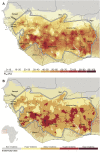Model-Based Geostatistical Mapping of the Prevalence of Onchocerca volvulus in West Africa
- PMID: 26771545
- PMCID: PMC4714852
- DOI: 10.1371/journal.pntd.0004328
Model-Based Geostatistical Mapping of the Prevalence of Onchocerca volvulus in West Africa
Abstract
Background: The initial endemicity (pre-control prevalence) of onchocerciasis has been shown to be an important determinant of the feasibility of elimination by mass ivermectin distribution. We present the first geostatistical map of microfilarial prevalence in the former Onchocerciasis Control Programme in West Africa (OCP) before commencement of antivectorial and antiparasitic interventions.
Methods and findings: Pre-control microfilarial prevalence data from 737 villages across the 11 constituent countries in the OCP epidemiological database were used as ground-truth data. These 737 data points, plus a set of statistically selected environmental covariates, were used in a Bayesian model-based geostatistical (B-MBG) approach to generate a continuous surface (at pixel resolution of 5 km x 5km) of microfilarial prevalence in West Africa prior to the commencement of the OCP. Uncertainty in model predictions was measured using a suite of validation statistics, performed on bootstrap samples of held-out validation data. The mean Pearson's correlation between observed and estimated prevalence at validation locations was 0.693; the mean prediction error (average difference between observed and estimated values) was 0.77%, and the mean absolute prediction error (average magnitude of difference between observed and estimated values) was 12.2%. Within OCP boundaries, 17.8 million people were deemed to have been at risk, 7.55 million to have been infected, and mean microfilarial prevalence to have been 45% (range: 2-90%) in 1975.
Conclusions and significance: This is the first map of initial onchocerciasis prevalence in West Africa using B-MBG. Important environmental predictors of infection prevalence were identified and used in a model out-performing those without spatial random effects or environmental covariates. Results may be compared with recent epidemiological mapping efforts to find areas of persisting transmission. These methods may be extended to areas where data are sparse, and may be used to help inform the feasibility of elimination with current and novel tools.
Conflict of interest statement
The authors have declared that no competing interests exist.
Figures







References
-
- London Declaration on Neglected Tropical Diseases. Uniting to combat neglected tropical diseases: Ending the neglect and reaching 2020 goals. 2012. [http://unitingtocombatntds.org/sites/default/files/resource_file/london_...]. Accessed 30 November 2015.
-
- World Health Organization. Accelerating work to overcome the global impact of neglected tropical diseases–A roadmap for implementation. 2012. [http://www.who.int/neglected_diseases/NTD_RoadMap_2012_Fullversion.pdf]. Accessed 30 November 2015.
-
- Kim YE, Remme JH, Steinmann P, Stolk WA, Roungou JB, Tediosi F. Control, elimination, and eradication of river blindness: scenarios, timelines, and ivermectin treatment needs in Africa. PLoS Negl Trop Dis. 2015;9(4): e0003664 (Correction in PLoS Negl Trop Dis. 2015;9(5): e0003777). 10.1371/journal.pntd.0003664 - DOI - PMC - PubMed
-
- Bradley JE, Whitworth J, Basáñez MG. Onchocerciasis In: Wakelin D, Cox F, Despommier D, Gillespie, editors. Topley and Wilson’s Microbiology and Microbial Infections. Volume Parasitology. 10th edition London: Hodder Arnold; 2005. pp: 781–801.
-
- Murdoch ME, Hay RJ, Mackenzie CD, Williams JF, Ghalib HW, Cousens S, et al. A clinical classification and grading system of the cutaneous changes in onchocerciasis. Br J Dermatol. 1993;129(3): 260–269. - PubMed
Publication types
MeSH terms
Grants and funding
LinkOut - more resources
Full Text Sources
Other Literature Sources

